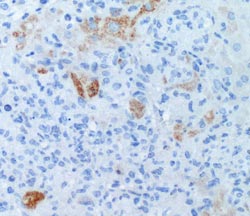Live and let die – Protein prevents immune cell suicide

Liver cells under the microscope. Apoptotic cells are stained in brown, cell nuclei are blue.<br>HZI / Schmitz <br>
Now, scientists at the Helmholtz Centre for Infection Research (HZI) Braunschweig and at the Otto von Guericke University (OvGU) Magdeburg have published their findings in the renowned European Journal of Immunology.
Apoptosis, programmed cell death, is a kind of cellular suicide program. If something triggers it, the cells perish in a controlled manner. A certain type of white blood cell called a lymphocyte commits suicide by apoptosis, which is one way for the body to effectively shut down an immune response once a pathogen has been successfully fought off. To make sure this doesn’t happen until after the job is done, apoptosis is a tightly regulated process. If this regulation is lost, potential consequences include autoimmune diseases, neurodegenerative diseases, even different forms of cancer.
The protein c-FLIP figures prominently into how the body regulates this process. The protein exists as three different versions, or isoforms. While the roles of c-FLIP-L and c-FLIP-S isoforms are well established, until now relatively little has been known about the role of the c-FLIP-R isoform. Which is why Prof. Ingo Schmitz and the Braunschweig team of researchers decided to take a closer look at this particular isoform. What they found is that it confers protection on immune cells against the apoptosis program. “If c-FLIP-R is activated, lymphocytes are apoptosis-resistant,” says the head of the HZI’s Systems-oriented Immunology and Inflammation Research work group, who also teaches at the OvGU. “Apoptosis can take place only in the protein’s absence.”
Traditionally, insights like these are based on research on mice and have yet to be confirmed in humans. In this case, however, the exact opposite holds true: Schmitz and his team initially made their observations on human blood cells. Next, to test these findings at the organismal level, the researchers examined a certain strain of mice that were making c-FLIP in all of their blood cells. The result: “Although the animals’ immune system was unchanged, c-FLIP prevents their white blood cells from undergoing apoptosis,” explains immunologist Prof. Dunja Bruder, who also teaches in Magdeburg.
As a result, the mice are less susceptible to Listeria infections. The bacterium, which also infects humans, is transmitted via contaminated foods. “The mice have a lower bacterial count and a lesser extent of organ damage than is normally the case with Listeria,” says Bruder. Consistently high levels of c-FLIP, however, would permanently disable apoptosis in activated lymphocytes and could trigger different autoimmune diseases. The scientists are hoping to conduct further, more in-depth research on this particular topic.
Still, for Ingo Schmitz, there is one obvious potential medical benefit to the discovery: “If we were able to simply turn on c-FLIP-R, this would help strengthen the immune system.” Helping the body heal itself if you will. A highly promising approach that could prove important to pretty much every single disease. Schmitz is already working on mapping out the search for candidate active substances.
Original publication:
Tanja Telieps, Frida Ewald, Marcus Gereke, Michaela Annemann, Yvonne Rauter, Marc Schuster, Nana Ueffing, Dorthe von Smolinski, Achim D. Gruber, Dunja Bruder, Ingo Schmitz
c-FLIP-R modulates cell death induction upon T-cell activation and infection
European Journal of Immunology, 2013, DOI: 10.1002/eji.201242819
The Systems-oriented Immunology and Inflammation Research work group studies the molecular processes that sensitize immune cells to the body’s own tissues. The cellular suicide program apop-tosis figures prominently into this research.
The HZI’s Immune regulation work group studies the balance of the immune system in extreme situations. This includes, among others, simultaneous infection with different kinds of pathogens and the misguided attack of the body’s own parts.
The Helmholtz Center for Infection Research:
Scientists at the Helmholtz Center for Infection Research (HZI) are engaged in the study of different mechanisms of infection and of the body’s response to infection. Helping to improve the scientific community’s understanding of a given bacterium’s or virus’ pathogenicity is key to developing effective new treatments and vaccines.
http://www.helmholtz-hzi.de
The Otto von Guericke University Magdeburg:
One of the Otto von Guericke University Magdeburg Medical Faculty’s research emphases is “Immunology including the molecular medicine of inflammation” with the goal of developing new therapeutic approaches and their delivery to the patient.
http://www.uni-magdeburg.de
Weitere Informationen:
http://www.helmholtz-hzi.de/en/news_events/news/view/article/complete/live_and_let_die/
– This press release at helmholtz-hzi.de
http://dx.doi.org/10.1002/eji.201242819
– Link to the original publication
Media Contact
All latest news from the category: Life Sciences and Chemistry
Articles and reports from the Life Sciences and chemistry area deal with applied and basic research into modern biology, chemistry and human medicine.
Valuable information can be found on a range of life sciences fields including bacteriology, biochemistry, bionics, bioinformatics, biophysics, biotechnology, genetics, geobotany, human biology, marine biology, microbiology, molecular biology, cellular biology, zoology, bioinorganic chemistry, microchemistry and environmental chemistry.
Newest articles

“Nanostitches” enable lighter and tougher composite materials
In research that may lead to next-generation airplanes and spacecraft, MIT engineers used carbon nanotubes to prevent cracking in multilayered composites. To save on fuel and reduce aircraft emissions, engineers…

Trash to treasure
Researchers turn metal waste into catalyst for hydrogen. Scientists have found a way to transform metal waste into a highly efficient catalyst to make hydrogen from water, a discovery that…

Real-time detection of infectious disease viruses
… by searching for molecular fingerprinting. A research team consisting of Professor Kyoung-Duck Park and Taeyoung Moon and Huitae Joo, PhD candidates, from the Department of Physics at Pohang University…





















